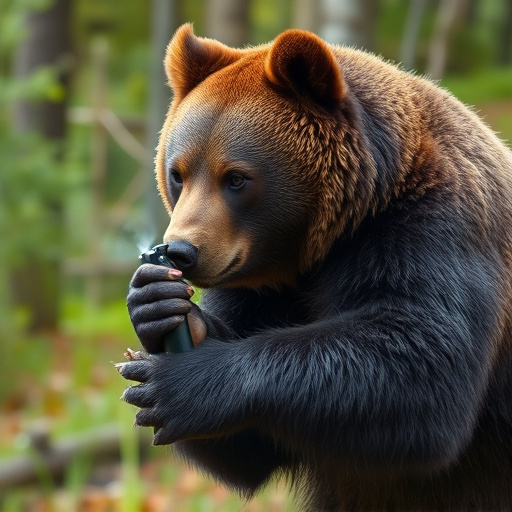The optimal bear spray distance for effective self-defense is 20-30 feet (6-9m), influenced by bear species, terrain, and sprayer skill. Holster design should enable swift access, with training focusing on "quick draw" techniques within this range. Regular practice, including testing response times and aiming at the bear's face, ensures accurate deployment in 3-5 seconds during encounters, potentially saving lives.
In bear country, a swift response can mean the difference between safety and danger. This article delves into the critical aspect of bear spray holster quick draw access, exploring key factors influencing your ability to deploy bear spray effectively. We analyze the best bear spray distance patterns, top holster design considerations, essential training for rapid deployment, and real-world scenarios testing response times. Equip yourself with the knowledge needed to navigate potential encounters confidently.
- Understanding Bear Spray Distance Patterns
- Key Factors Influencing Quick Draw Access
- Top Bear Spray Holster Design Considerations
- Effective Training for Rapid Deployment
- Real-World Scenarios: Testing Response Times
Understanding Bear Spray Distance Patterns
Understanding bear spray distance patterns is crucial for effective self-defense in potential encounters. Research suggests that the best bear spray distance pattern typically ranges from 20 to 30 feet (6 to 9 meters). This range allows users enough time to deploy the spray while staying out of the bear’s reach, as bears can react quickly and aggressively when threatened.
The optimal distance varies based on factors like bear species, terrain, and individual sprayer proficiency. For example, grizzly bears may have a slightly longer reaction time due to their size, giving users a slight advantage at the upper end of this range. Knowing and practicing draw techniques within this sweet spot ensures maximum effectiveness during an actual encounter, allowing quick access to bear spray for prompt protection.
Key Factors Influencing Quick Draw Access
When it comes to quick draw access for bear spray, several key factors come into play. One of the most critical aspects is the best bear spray distance pattern. Understanding the range at which your spray can effectively deter an attack is crucial. Manufacturers typically provide information on the ideal distance for optimal effectiveness, which varies depending on the product and environmental conditions.
Additionally, the design of the holster itself plays a significant role. Users should look for holsters that offer easy access, ensuring fingers can quickly reach the trigger without much movement or obstruction. The placement of the spray in relation to your hands is vital for fast deployment. Factors like weight distribution, grip strength, and the ease of drawing the spray from its holster directly impact how swiftly you can respond during an encounter with a bear.
Top Bear Spray Holster Design Considerations
When considering a bear spray holster for quick draw access, several key design elements should be top of mind. First and foremost, the holster must ensure a secure yet easy access to your bear spray can. This involves a balanced design that allows for a firm grip when drawing, while still enabling a swift motion to get the spray in play. The best bear spray distance pattern is typically around 20-30 feet, so the holster should facilitate a smooth, uninterrupted reach within this range.
Additional considerations include weatherproofing and comfort. In an outdoor setting, especially one teeming with wildlife, being able to deploy your bear spray effectively can mean the difference between safety and an encounter turned dangerous. Therefore, a durable, water-resistant design is paramount. Comfort is also crucial, as wearing the holster for extended periods should not cause fatigue or discomfort, ensuring you’re prepared at all times.
Effective Training for Rapid Deployment
Effective training is paramount when it comes to rapid deployment of bear spray, as it can be a lifesaver in encounters with aggressive bears. The key lies in mastering the “quick draw” technique, ensuring you can access and deploy the spray swiftly. Practice drawing the spray from its holster in various positions and stances, focusing on speed and accuracy.
Knowing the best bear spray distance pattern is crucial. Typically, the effective range of bear spray is between 20 to 30 feet (6 to 9 meters), but this can vary based on factors like wind and the type of spray. Training sessions should simulate real-life scenarios, encouraging individuals to practice drawing and spraying at different distances to ensure they’re comfortable and effective within this critical range.
Real-World Scenarios: Testing Response Times
In real-world scenarios, testing response times with a bear spray holster and quick draw access is crucial to understanding its effectiveness in high-pressure situations. The best bear spray distance pattern varies based on factors like the user’s skill level, the holster design, and environmental conditions. Studies have shown that individuals with proper training can deploy bear spray within 3–5 seconds, a critical window for deterring an aggressive bear attack.
During tests, users should aim for the bear’s face and eyes, as these areas are most sensitive to capsaicin, the active ingredient in bear spray. Consistent practice and regular evaluation of response times can help ensure that when faced with a real threat, individuals can access and deploy their bear spray quickly and accurately, potentially saving lives and reducing injury.
When it comes to self-defense in bear country, a bear spray holster designed for quick draw access can be a crucial tool. By understanding the best bear spray distance patterns, recognizing key factors that influence deployment speed, and considering top design features, you can ensure effective training and optimal response times in real-world scenarios. Remember, knowing how to navigate these critical seconds during an encounter can make all the difference in keeping you safe.
